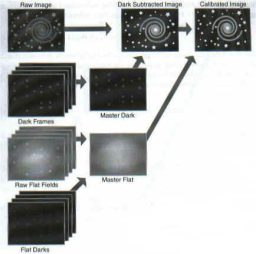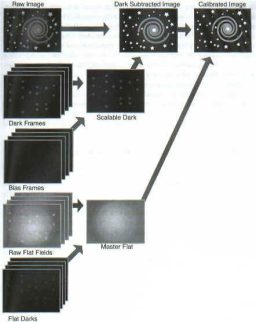Image Calibration
Basic calibration requires one or more (preferably five) dark frames combined together to create a master dark frame. The resulting dark frame is subtracted from the raw. This removes dark current, hot pixels and bias level. Basic calibration will not correct for CCD sensitivity variation or vignetting. Dark Frames must be the same exposure length as your raw image and should be taken during the same session as the Raws, using the same optical settings (focus, temp, position, eyepiece, etc.)
Standard calibration requires multiple dark frames (again at least five), flat frames (fifteen or more), and flat dark frames (fifteen or more). The flats can be taken at an exposure length from 2 to ten seconds. Flat Darks are taken with the lightbox off but same integration times. Images processed with standard calibration have bias level correction, dark current correction, hot pixels removed and no vignetting. Integration time of these frames must be the same length of time as the raw exposure. The Flat frames will aid in reducing or eliminating those nasty dust donuts.
Advanced Calibration is used to achieve the highest level of image calibration. The observer is ultimately relieved of the need to have equal integration time for images and their subsequent dark frames. Master dark frames can be used to calibrate all images independent of the raw's exposure length. Flat Darks Frames should have the same exposure length as the raw flat frames.
©Copyright. All rights reserved.
We need your consent to load the translations
We use a third-party service to translate the website content that may collect data about your activity. Please review the details in the privacy policy and accept the service to view the translations.



